Mid-season hybrid of cucumbers “Prestige” from domestic breeders
Among the many varieties of cucumbers, the first generation hybrid Prestige stands out for its long-lasting and high yield, excellent fruit taste and resistance to temperature changes. Planting a crop and caring for it requires compliance with certain rules, which we will discuss in the article.
Description of cucumbers
Hybrid produced by the agricultural company "Sedek" was included in the State Register of the Russian Federation in 2007. Recommended for cultivation in open ground in the Central Black Earth and West Siberian regions.
Fruit ripening time is average (40–50 days), which saves from the invasion of insect pests and fungal diseases. Pollination is parthenocarpic (no insects required). Prestige f1 bears fruit equally well both in a greenhouse and in open ground.
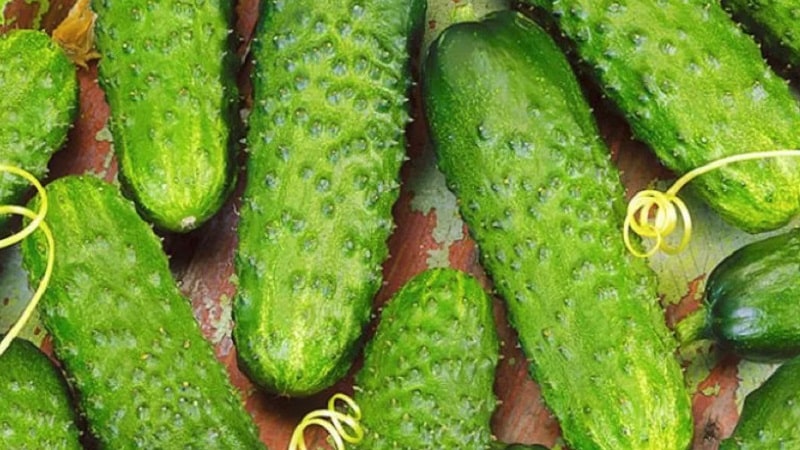
Distinctive features
Plants of indeterminate type, medium height, female flowering type. The leaves are medium dark green. The ovaries are formed in bunches of 3-4 pieces.
Cylindrical fruits. The color is dark green with small white stripes and slight pubescence. The skin is covered with small whitish prickly spines. The length of cucumbers is 8-9 cm, weight is about 70–90 g.
Composition and properties
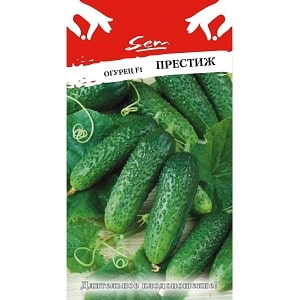 Calorie content of fruits per 100 g - 15 kcal.
Calorie content of fruits per 100 g - 15 kcal.
The nutritional value:
- proteins - 0.8 g;
- carbohydrates - 2.5 g;
- fats - 0 g.
Fiber in vegetables has a beneficial effect on functioning of the gastrointestinal tract.The fruits contain vitamins B, C, E, K, organic acids, macro- and microelements (potassium, sodium, phosphorus, calcium, magnesium, fluorine, iron, zinc).
Cucumbers are 95% composed of special structured water; they cleanse the body of toxins, heavy metals and toxins.
Characteristics
Prestige has proven itself well among vegetable growers due to the following characteristics:
- the root system is developed, so the bushes easily absorb moisture, oxygen and nutrients from the soil (the length of the rhizomes is up to 30 cm);
- powerful and strong vines of medium length (80–150 cm), but the bushes themselves are large;
- female inflorescences predominate;
- the hybrid does not require pollination by insects;
- the leaves are dark green, have a smooth structure and wavy edges;
- The taste of the fruit is excellent: no bitterness, slightly sweet, crunchy in the mouth;
- the yield is high: 1 bush produces up to 6 kg of vegetables;
- the hybrid is resistant to diseases and temperature changes;
- seedlings easily tolerate transplants.
Other hybrids for your site:
Mirabella cucumbers for greenhouses and open ground
How to grow your own
Prestige cucumbers grow best in warm neutral soil. Planting begins when the air temperature is within +17...+20°C. The crop is grown by seedlings and sowing in open ground.
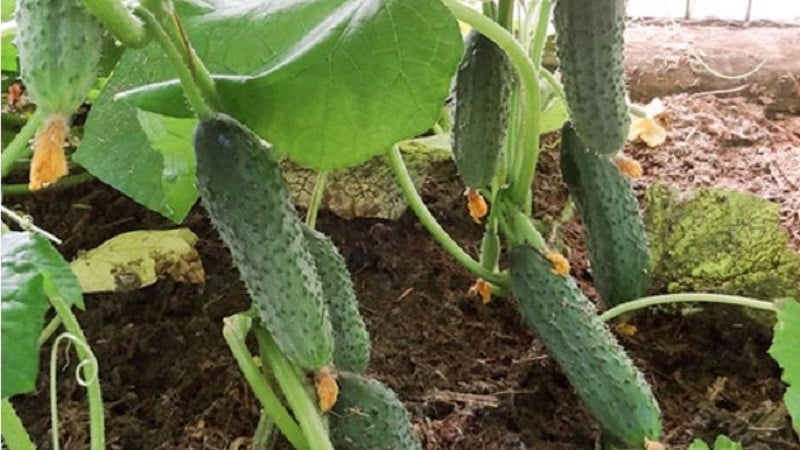
Planting seeds and seedlings
The choice of a specific growing method depends on the preferences of gardeners and the desire to get an earlier or, conversely, late harvest.
Cucumber seedlings
To harvest vegetables early, they are grown using seedlings., and then dive into the greenhouse. The best time for sowing in this case is the beginning of April.Planting material is pre-calibrated in a 3% salt solution. The floating seeds are removed, and those that have settled to the bottom are washed in water and planted in disposable cups. This will minimize the stress of picking up a permanent location. The grains are buried 1.5–2 cm, and the top of the container is covered with film.
By the way! Peat pots are ideal for seedlings. The bushes are placed in the ground along with them. Plastic containers are chosen with a volume of 0.5 liters. Holes are made at the bottom to drain excess liquid.
After planting, the seeds will sprout in 5–7 days. A crop with 3-4 leaves is transplanted into the ground in May, when there is no threat of frost. The soil is prepared in the fall: it is dug up with manure (10 kg per 1 m2), treated with copper sulfate against pests. Holes are dug every 50 cm into which the seedlings are carefully transferred. The top soil is moistened with warm water.
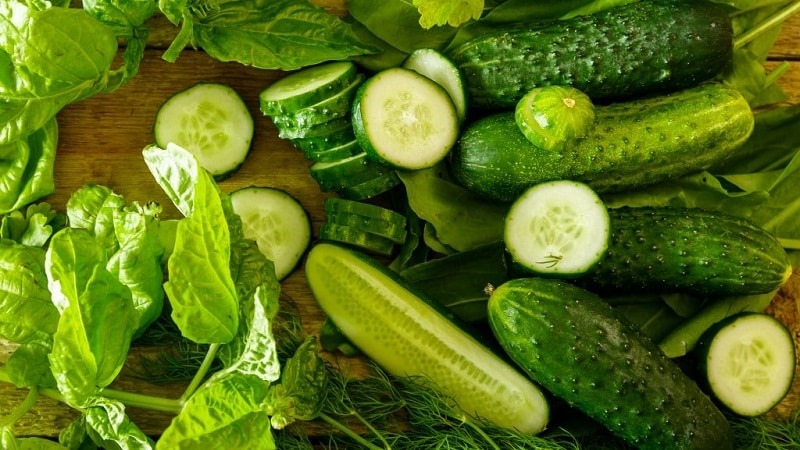
Sowing in the ground
Sowing on the beds is carried out on warm May or June dayswhen the soil is well warmed by sunlight and the weather is stable.
First, the soil is mixed with cow manure diluted in water and dug up. The distance between the holes is maintained at 30 cm. After planting, the holes are watered and covered with film. After the sprouts appear, it is removed, and after 10 days the planting is thinned out, removing weak sprouts.
Step-by-step cultivation and care
To obtain a consistently high yield Cucumbers are provided with proper care:
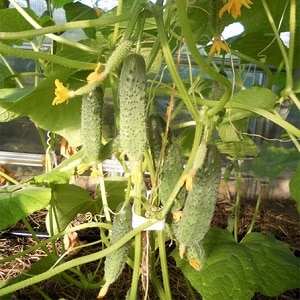 Water the garden crop as needed. Until the buds appear, 3 liters of water are poured under the bushes every week. At the stages of flowering and fruit formation - 6 liters every 3 days. In dry, hot weather, the frequency of irrigation is increased.
Water the garden crop as needed. Until the buds appear, 3 liters of water are poured under the bushes every week. At the stages of flowering and fruit formation - 6 liters every 3 days. In dry, hot weather, the frequency of irrigation is increased.- Once a week, the soil is loosened to saturate the roots with oxygen.
- During the growing season, 4 additional feedings are applied. 10–14 days after picking seedlings or sowing, nitrogen fertilizers or superphosphate are used. At the beginning of flowering, potassium, calcium and phosphorus are added, during fruiting - potassium-phosphorus compounds, and 2 weeks after - complex mineral fertilizers. Such products are replaced with a solution of bird droppings (1 kg per 15 liters of water), cow manure (1 kg per 8 liters) or ash (2-3 tablespoons per 1 liter of water).
- The fruits are harvested immediately as they ripen in order to preserve the further productivity of the hybrid.
Features of cultivation and possible difficulties
Features of cultivation:
- in open ground, cucumbers are protected from spring frosts by covering with agrofibre or film;
- plantings are watered regularly, especially if the summer is hot and dry: this will relieve the fruits from developing bitterness;
- until the ovaries have formed, the seedlings are watered every 2-3 days;
- excess foliage and shoots are removed, and the bushes are hilled up.
Read also:
The domestic hybrid “Garland” will delight you with a rich harvest
Diseases and pests
The hybrid withstands many diseases, but in unfavorable weather conditions (frequent rains, high humidity) and improper care is susceptible downy mildew, tobacco mosaic, white rot.
For prevention, the bushes are sprayed with a 3% solution of copper sulfate. Diseased areas of plants are removed.
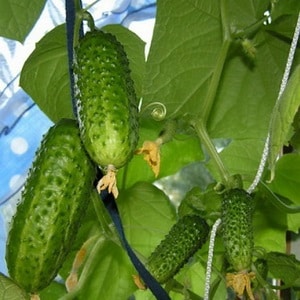 Main pests of cucumber plants cause significant damage to culture:
Main pests of cucumber plants cause significant damage to culture:
- melon aphid - infusions of potato peelings, celandine, tree resin, karbofos (40 g per 10 liters of water) are used against insects;
- spider mites - when pests are detected, the bushes are treated with fungicides (Aktara, Confidor) or tobacco infusion;
- whitefly - sticky sweetened traps are placed, the bushes are sprayed with onion or garlic infusion;
- slugs - water the soil around the cucumbers with a solution of hot pepper and sprinkle with dry mustard.
For prevention, cucumbers are sprayed with folk remedies. They have a mild effect and are safe for plants and humans. Effectively whole skimmed milk with iodine (30 drops per 1 liter) and laundry soap (20 g). The mixture is diluted in a bucket of water and used against viral and fungal diseases (white and speckled mosaic, white rot). Additionally, the bushes are irrigated with herbal infusions of wormwood, celandine, and garlic arrows.
Important! Failure to follow the rules of crop rotation provokes the appearance of insects and disease infection. The best predecessors of cucumbers are potatoes, legumes, onions, and cabbage.
Harvesting and application
Cucumbers are harvested en masse in July–August. The fruits may ripen unevenly, so harvesting lasts until September. The skin of hybrid cucumbers is covered with small prickly thorns, so gloves are used when removing fruits from the bush.
The harvest is laid out in wooden boxes and placed in a cool place.. The product is stored for about 1 month. The fruits are used for preparing summer salads, canning, and pickling. Pickled cucumbers are crispy and dense, without voids or bitterness.
Advantages and disadvantages
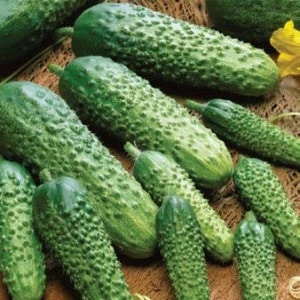 Advantages of the Prestige hybrid:
Advantages of the Prestige hybrid:
- early fruit ripening;
- parthenocarpic type of pollination;
- excellent taste of cucumbers, dense pulp;
- versatility in cooking;
- resistance to adverse weather conditions;
- long fruiting.
Disadvantages of gardening:
- seeds from the grown harvest are not suitable for planting next time: the second generation does not inherit the quality of the first. To obtain a pure hybrid, you need to buy planting material;
- To prevent diseases and pest attacks, preventive measures are taken.
The guarantee of a rich harvest — timely watering, fertilizing, loosening the soil, protection from diseases and pests.
Reviews
Vegetable growers note the unpretentiousness of the hybrid, the yield and taste of the fruit:
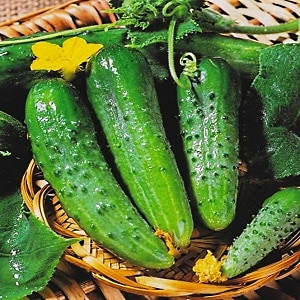 Victor, Krasnodar: “Last year my wife bought a bag of Prestige seeds to try. The hybrid showed good results in terms of yield. Cucumbers were grown through seedlings and transferred to the ground in mid-May. It is easy to care for: the hybrid is not capricious. Watered, like other cucumbers, 3-4 times a week. The fruits inside are without voids, the outside is smooth and shiny, as in the photo. A little of the extra harvest was sold, and the rest was distributed to family and friends. I recommend!".
Victor, Krasnodar: “Last year my wife bought a bag of Prestige seeds to try. The hybrid showed good results in terms of yield. Cucumbers were grown through seedlings and transferred to the ground in mid-May. It is easy to care for: the hybrid is not capricious. Watered, like other cucumbers, 3-4 times a week. The fruits inside are without voids, the outside is smooth and shiny, as in the photo. A little of the extra harvest was sold, and the rest was distributed to family and friends. I recommend!".
Igor, Kaluga: “For years now I have been buying Prestige cucumber seeds for growing in a greenhouse. Unlike many other hybrids and varieties, the description of this crop on the packaging fully corresponds to reality: it does not require pollination, the fruits ripen quickly and smoothly. I am satisfied with the taste and yield of the crop. Pickles from a jar and with fried potatoes are especially delicious.”.
Alevtina, village Alekseevka, Samara region: “I grew Prestige in open ground - the hybrid met my expectations. It needs regular watering, fertilizing, and does not require special care. My neighbors at the dacha liked my cucumbers and will plant them this year too.”.
Conclusion
Prestige is a hybrid that is grown by seed and seedling methods.Cultivation is simple and includes timely fertilizing, watering, loosening and mulching of the soil. The bushes bear fruit several times, the vegetables are juicy and crisp, without bitterness.
Disadvantages of the culture are susceptibility to attacks by spider mites, aphids, whiteflies, and slugs. Biological insecticides are used against them, an optimal level of humidity is maintained for prevention, and the rules of crop rotation are observed.